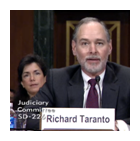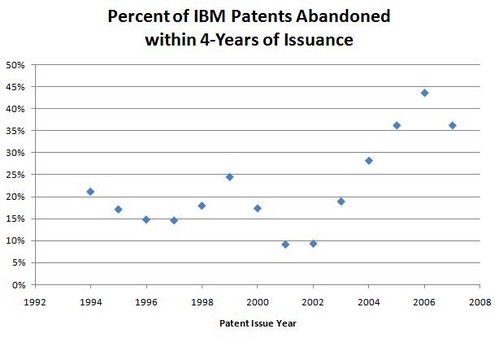Guest Post by Professor Jorge L. Contreras.
For those of us who have been following the telecom patent battles, something remarkable happened a couple of weeks ago. On February 7, the Wall St. Journal reported that, back in November, Apple sent a letter[1] to the European Telecommunications Standards Institute (ETSI) setting forth Apple’s position regarding its commitment to license patents essential to ETSI standards. In particular, Apple’s letter clarified its interpretation of the so-called “FRAND” (fair, reasonable and non-discriminatory) licensing terms that ETSI participants are required to use when licensing standards-essential patents. As one might imagine, the actual scope and contours of FRAND licenses have puzzled lawyers, regulators and courts for years, and past efforts at clarification have never been very successful. The next day, on February 8, Google released a letter[2] that it sent to the Institute for Electrical and Electronics Engineers (IEEE), ETSI and several other standards organizations. Like Apple, Google sought to clarify its position on FRAND licensing. And just hours after Google’s announcement, Microsoft posted a statement of “Support for Industry Standards”[3] on its web site, laying out its own gloss on FRAND licensing. For those who were left wondering what instigated this flurry of corporate “clarification”, the answer arrived a few days later when, on February 13, the Antitrust Division of the U.S. Department of Justice (DOJ) released its decision[4] to close the investigation of three significant patent-based transactions: the acquisition of Motorola Mobility by Google, the acquisition of a large patent portfolio formerly held by Nortel Networks by “Rockstar Bidco” (a group including Microsoft, Apple, RIM and others), and the acquisition by Apple of certain Linux-related patents formerly held by Novell. In its decision, the DOJ noted with approval the public statements by Apple and Microsoft, while expressing some concern with Google’s FRAND approach. The European Commission approved Google’s acquisition of Motorola Mobility on the same day.
To understand the significance of the Apple, Microsoft and Google FRAND statements, some background is in order. The technical standards that enable our computers, mobile phones and home entertainment gear to communicate and interoperate are developed by corps of “volunteers” who get together in person and virtually under the auspices of standards-development organizations (SDOs). These SDOs include large, international bodies such as ETSI and IEEE, as well as smaller consortia and interest groups. The engineers who do the bulk of the work, however, are not employees of the SDOs (which are usually thinly-staffed non-profits), but of the companies who plan to sell products that implement the standards: the Apples, Googles, Motorolas and Microsofts of the world. Should such a company obtain a patent covering the implementation of a standard, it would be able to exert significant leverage over the market for products that implemented the standard. In particular, if a patent holder were to obtain, or even threaten to obtain, an injunction against manufacturers of competing standards-compliant products, either the standard would become far less useful, or the market would experience significant unanticipated costs. This phenomenon is what commentators have come to call “patent hold-up”. Due to the possibility of hold-up, most SDOs today require that participants in the standards-development process disclose their patents that are necessary to implement the standard and/or commit to license those patents on FRAND terms.
On its face, it is easy to see why a FRAND commitment might reassure implementers of a standard. If a patent is essential to the standard, the patent holder must license the patent on terms that are fair, reasonable and non-discriminatory. Unfortunately, the devil has proven to be in the details of FRAND, and no two companies seem to have the same view of what constitutes fair, reasonable or non-discriminatory licensing terms. This lack of agreement has troubled regulators for some time and has led to an increasing number of litigation claims alleging that one party or another to a standards effort has failed to comply with its FRAND obligations.
The February FRAND statements by Apple, Microsoft and Google are thus informative and potentially of great importance. To understand the statements, and why the DOJ viewed them differently, it is helpful to compare them side-by-side. The following table summarizes what Apple, Microsoft and Google said FRAND means to them.
|
|
Apple (relating to cellular telephony standards) |
Microsoft |
Google (limited to Motorola Mobility patents) |
|
1. Prior Commitments. Will the patent holder honor FRAND obligations of prior patent owners? |
A party acquiring patents from someone who made FRAND commitments must abide by those commitments |
n/a |
G will honor Motorola’s existing FRAND commitments |
|
2. Onward Transfer. Will the patent holder require future owners of the patent to comply with its FRAND obligations? |
n/a |
M will require transferees to abide by its FRAND commitments |
G will use “best efforts” to ensure that transferees abide by its FRAND commitments |
|
3. Reciprocity. Will the patent holder require that the licensee grant a license back to the licensor? |
n/a |
M will only require a grant-back of the licensee’s patents that are essential to the same standard |
G will only require a grant-back of the licensee’s patents that are essential to the same standard |
|
4. Royalty Rate. Will the patent holder commit to a maximum royalty rate? |
Standards-essential patents should be licensed at an “appropriate” royalty rate reflective of the licensor’s share of the overall number of patents essential to the standard |
n/a |
Maximum per-unit royalty of 2.25% of product net selling price |
|
5. Injunctive Relief. Will the patent holder seek injunctive relief against unlicensed implementers of the standard? |
A party making a FRAND commitment must not seek injunctive relief on patents subject to the commitment |
M will not seek an injunction … on the basis of [standards-] essential patents |
G will not seek an injunction on the basis of standards-essential patents, during a reasonable negotiation period and if the other party makes a similar commitment |
Despite their differences, the three FRAND statements exhibit some important similarities. All three, for example, support the notion that FRAND commitments should “travel with the patent”. This is an important acknowledgement, as such commitments typically lack the necessary elements of a bilateral contractual arrangement, and have been questioned in both corporate acquisitions and bankruptcy proceedings (see In re Nortel Networks Inc., Order – Case No. 09-10138(KG) (Bankruptcy Ct. D.Del., Jul. 11, 2011)).
The three statements also address the question of injunctive relief. Numerous commentators have questioned whether injunctive relief is an appropriate remedy for holders of standards-essential patents, particularly in view of the Supreme Court’s four-part analysis under eBay v. MercExchange LLC, 547 U.S. 388 (2006). In 2011, the Federal Trade Commission suggested that injunctive relief might not be justified in the standards context, writing that “[a] prior [F]RAND commitment can provide strong evidence that denial of the injunction and ongoing royalties will not irreparably harm the patentee.” Federal Trade Comm’n, The Evolving IP Marketplace – Aligning Patent Notice and Remedies with Competition 235 (2011). In their February FRAND statements, Apple and Microsoft each commit not to seek injunctions on the basis of their standards-essential patents. Google makes a similar commitment, but qualifies it in typically lawyerly fashion (Google’s letter is more than 3 single-spaced pages in length, while Microsoft’s simple statement occupies about a quarter of a page). In this case, Google’s careful qualifications (injunctive relief might be possible if the potential licensee does not itself agree to refrain from seeking an injunction, if licensing negotiations extended beyond a reasonable period, and the like) worked against it. While the DOJ applauds Apple’s and Microsoft’s statements “that they will not seek to prevent or exclude rivals’ products form the market”, it views Google’s commitments as “less clear”. The DOJ thus “continues to have concerns about the potential inappropriate use of [standards-essential patents] to disrupt competition”.
It is not clear whether the DOJ’s criticism of Google’s stance on injunctive relief, or its endorsement of Apple’s and Microsoft’s positions, is warranted. After all, none of the February FRAND statements was made directly to the DOJ, formed part of a consent order, or even rose to the level of a contractual commitment. But whatever their actual legal effect, it is certainly preferable to have such statements than not, and perhaps this recent wave of “clarifications” will help courts to interpret the array of FRAND-based claims that will inevitably be brought over the next several years.
Mr. Contreras is a Visiting Associate Professor at American University – Washington College of Law and will join the faculty as an Associate Professor this summer. His research focuses on the impact of intellectual property rules on scientific and technological development, including in the area of technical standard-setting. He is the editor of the ABA's Standards Development Patent Policy Manual and has written numerous articles and book chapters relating to intellectual property and standards.
 Mr. Taranto is an appellate and Supreme Court litigator at the small but well established DC firm of Farr & Taranto. He has participated in dozens of Federal Circuit patent appeals, including several Rambus cases, Verizon v. Cox, Lucent v. Gateway, Syngenta v. Monsanto, and others. Mr. Taranto has argued three IP cases before the U.S. Supreme Court: MGM v. Grokster (contributory copyright infringement), Warner Jenkinson v. Hilton Davis (patent law doctrine of equivalents), and Two Pesos v. Taco Cabana (trade dress infringement). He has taught a variety of classes as an adjunct professor, including patent law at Harvard in 2002. Taranto graduated from Yale Law School in 1981. He clerked for Judge Abraham Sofaer on the Southern District of New York; Judge Robert Bork on the D.C. Circuit; and Justice Sandra Day O’Connor on the Supreme Court.
Mr. Taranto is an appellate and Supreme Court litigator at the small but well established DC firm of Farr & Taranto. He has participated in dozens of Federal Circuit patent appeals, including several Rambus cases, Verizon v. Cox, Lucent v. Gateway, Syngenta v. Monsanto, and others. Mr. Taranto has argued three IP cases before the U.S. Supreme Court: MGM v. Grokster (contributory copyright infringement), Warner Jenkinson v. Hilton Davis (patent law doctrine of equivalents), and Two Pesos v. Taco Cabana (trade dress infringement). He has taught a variety of classes as an adjunct professor, including patent law at Harvard in 2002. Taranto graduated from Yale Law School in 1981. He clerked for Judge Abraham Sofaer on the Southern District of New York; Judge Robert Bork on the D.C. Circuit; and Justice Sandra Day O’Connor on the Supreme Court. 